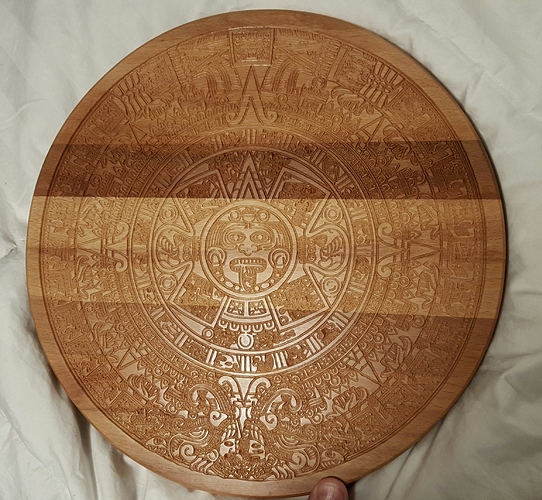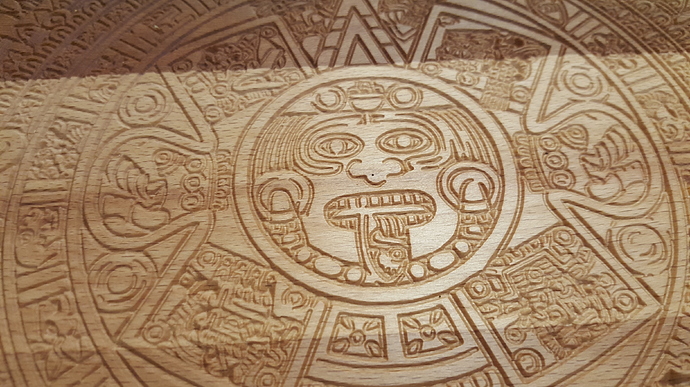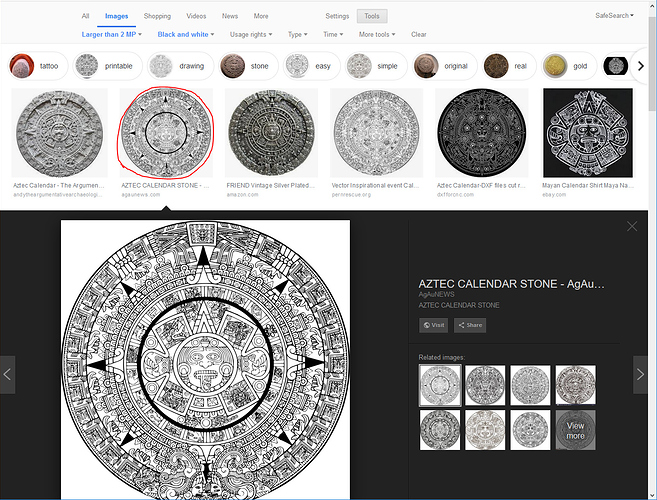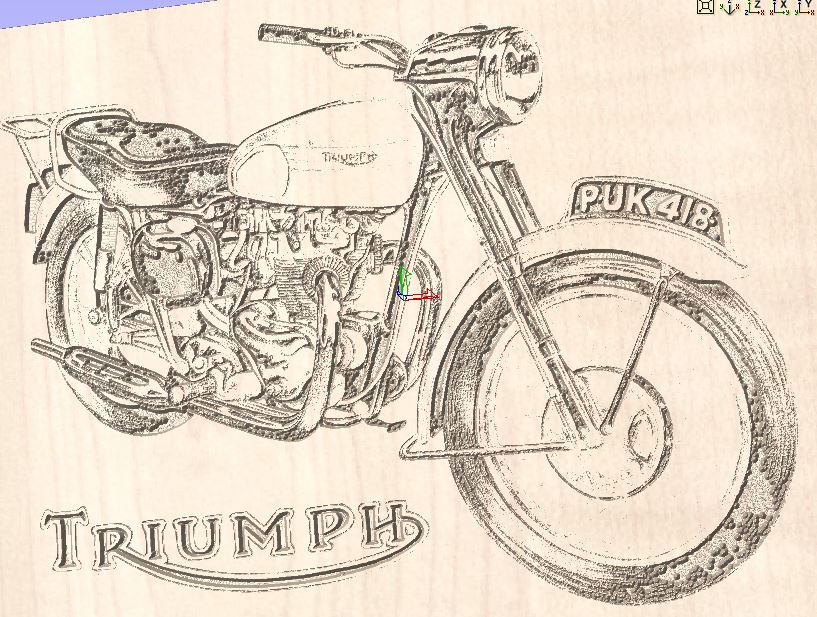I’m trying my damndest to learn f360. I’v spent dozens of hours watching videos and working on simple 3D modeling and now i’m trying to challenge myself with an aztec calendar. I downloaded a file from a forum and have uploaded it into f360. I cant figure out how to make the toolpaths now. Any help is appreciated.
I don’t believe the Aztec calendar is suited to doing easily in Autodesk Fusion 360 — better for Vectric, since it has better support for V carving.
I’m not a Fusion360 person, but I will say that in Vectric VCarve that would be a trivial task assuming the image is pretty clean.
Dan
I downloaded a black and white image and used F-Engrave with a 60deg V-bit.
F-Engrave has a slightly steep learning curve, but I just watched a couple of YouTube videos and made this. I used an ugly cutting board in case I screwed it up.
If you do want to do this in Fusion360, you may get inspiration here : https://www.youtube.com/watch?v=hQbz8abi3RU
Thank you for the replies. I’ve been trying to work out of fusion 360 because it is free for hobbyists and I just don’t have the funds to get V carve pro right now. Learning CAD and CAM from scratch is a pretty steep learning curve and I’m doing well in carbide create and carbide motion but once I jump in to fusion 360 im a mess.
I’d recommend a different file for learning Fusion 360. As others have said, although it can be done, that type of job is not Fusion’s thing. F-engrave is a free option for V-carving. If your main goal is V-carving vector files, I don’t think Fusion is where you want to spend your time.
I’m wanting to learn fusion to be able to carve in full 3D. Sounds like Ill be using another program for v carving. Are there any other areas where fusion is really lacking?
The issue is that Fusion 360 - the CAD portion - is for creating the 3D models. Fusion 360 - the CAM portion is for taking creating the tool paths based on the the 3D models and raw material and machining (within the limitations of your machine) the raw material into the designed product.
What you want to do - take an image and V-carve it - is more of an art type function. Unless you have a 3D model of the Aztec calendar, you are trying to take a 2D image and extrude it into a 3D model using a program that wasn’t really designed to do that.
I happen to use SolidWorks, but the process applies to all 3D CAD programs. Start simple and learn the functions of the program. Use the simple models to learn the CAM side of the program and work your way up to more difficult objects and machining processes.
I also have Vectric V-Carve, but I would never use V-Carve to design and machine a support bracket, nor would I use SolidWorks to design and cut a V-carved sign.
Yep, the right tool for the job. Unfortunately when you only have a hammer, everything starts to look like a nail. 
I’m in the same boat with F360, I have watched dozen of videos, tried the exercises but at some point, something happens and the project gets messed-up. I find the interface daunting, it takes me a fair bit of time to find the functions in the menus. I purchased V-Carve and I find it relatively easy to use it even if it is a fairly capable program. I know that I will have to learn F360 at some point to create 3D aluminum parts but I know it will take me a fair bit of time to wrap my head around it.
Can you share the file you downloaded? Was it a vector or bitmap image?
I did a Google image search for “Aztec Calendar” and then click the “Tools” button to modify the search.
And:
change SIZE to “Larger than 2MP” and
change COLOR to “Black and white”.
Here is the search with those filters turned on.
EDIT:
I’m pretty sure I used this image, but I am not at home to double-check.
I used the red circled one. I clicked on it and saved it from the preview.
I don’t see this a vcarvable image. I could see it being traced. Vcarve is designed to route a vshaped groove between two boundaries. Tracing follows the lines. Tracing will give each line the same thickness and depth while vcarving varies the depth and thickness. Vcarving works with enclosed areas/boundaries and a lot of the areas in the calendar are not closed. Tracing can rout unclosed lines/paths. I do tracing all the time with F360. What I would do with this image is take the jpeg download and put it into Inkscape. In there, I would convert it to paths and save it out as an svg file. In F360, I would import the svg, size and locate it. Then I would switch to CAM and trace the outlines with some bit (I generally use a 7.5 degree bit for tracing). I see a lot of people here putting out uniformed disinformation. F360 is indeed capable of doing 2.5 as well as 3D work. It can do engraving and tracing. I’m not saying F360 is the BEST tool to use, but it is the one you asked about. Finally, you really should ask questions about F360 in the Fusion 360 forum. Few people here (obviously) have a good working knowledge of the program.
I’d like to clear up a few things;
I did not ask about Fusion 360. That was another user. I offered my opinion regarding what program would be better at specific operations. Like you I agree that Fusion 360 is not the best at doing that.
My mistake was not explaining myself fully. I was in a rush, so I left out some info that changed the intended statement. Yes, Fusion 360 can take a 2D vector image and extrude the closed paths into 3D solids. I do this frequently with SolidWorks to make 3D prints of logos. I meant to say that Fusion 360 was not really designed with V-carving in mind. Yes, it can do it, but it is not easy. I can cut my yard with a weed wacker, but it would be a lot easier on a riding lawn mower.
Also, you asked what image I used. I said I was not home to double-check, but that is the process I used, and I am pretty sure that is the image I used.
I said that I engraved the image using F-Engrave. F-Engrave uses black and white bitmap images as an input. I took that image and converted it to a bitmap.
I agree, there are a lot of people putting out (whether intentional or not) incorrect or misleading information. By the way, tracing a vector image with a v-bit is not the same as V-carving.
I was replying to OP, who asked about vcarving in Fusion. I asked him/her to share the image and when I saw the screenshot from MadHatter, I just assumed it was OP Munkiestyle answering. After all, who else would answer for him; only he knows what he downloaded. As for the “by the way” comment, reread my post. At no point did I say that tracing with a vbit is vcarving.
Still new to VCarve Pro but I used the JPG image, converted it to SVG using the on-line converter then imported it into VCarve Pro, resized it to 12 in then created toolpaths. Here is the result in preview; not perfect but not bad for a 15 min exercise.
I really appreciate everyone’s input. I am definitely gaining a better grasp on the capabilities of which program is better for doing what. Is the extra investment worth it to go with V carve pro or is V carve good enough for something like this. I will also be downloading F engrave when I get home from work and giving that a shot also
The pro version provides the ability to carve any size pieces while the desktop version is limited to something like 12X12in (check the site). The upgrade from one version to the next is the difference in price so if you want to go to Pro from desktop you only pay the difference, same with going to Aspire. So if you plan on carving limited size pieces, go for desktop. You can download a trial version of the software to try, it has full functionality but you cannot cut any files you created but some files can be downloaded from the Vectric site to try cutting.
Yea, it’s 24"x24", and a few other differences:
https://www.vectric.com/products
Like you said the cool thing about the Vectric offerings is you can upgrade incrementally and just pay the difference in price. I personally own an XXL and use VCarve Desktop with the 24" limit, but you can also tile tool paths and cut an unlimited size. Someday I may upgrade, mostly for the added features, but the initial $350 outlay for Desktop in my opinion was money well spent. As someone else stated, right tool or the job, I’m not gonna try to draw up new motor mounts for my motorcycle with it, but I’ll do V carves, signs, 3D reliefs like crazy.
The trace bitmap feature is pretty good too:
Dan
I apologize for my snippy response. I had the browser open in a small window on my desktop, so when I refreshed the page I saw the bottom half of your post, and without scrolling up any farther than to read the first half of your post, I assumed you were replying to me.





